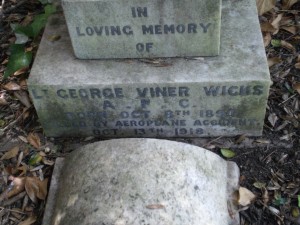William Harringay Neate
Private 1343
5th Battalion Australian Infantry A.I.F.
Division 6
William Harringay Neate, is recorded as William Henry Neate, on the headstone of the family grave number 6789. The inscription states that he was “Killed in Action at Anzac” on 19th May 1915 aged 32.
It is believed that his father, also called William, served in the British Army prior to the Great War, he was born in Bradfield, Berkshire and his sister, Sarah, who lived with the family in 1901 was born in Tilehurst, Reading. William’s mother was Mary A Neate. It has not been possible to discover futher details about William Harringay Neate although in 1901 he was living with his mother and father in Gosport. He was then 19 but no occupation was given.
The Gallipoli landings took place on the 25th April 1915. Until 6th May there was persistent heavy fighting with serious losses on both sides. It became obvious by the 9th May that the troops would need time to reorganise and strengthen their positions. Among the heat and flies and constant sniper fire the Anzacs dug to improve the depth of gullies and trenches. For safety periscopes were in constant use. In many places the front lines were only yards apart and in No-Mans land the decaying bodies of Turkish soldiers rotted in the sun. The Turkish commanders Essad and Kemel gave up their vision of driving the Anzacs into the sea and planned, instead, to mount a full scale attack. 40,000 Turks were assembled quietly during the 18th May in gullies and valley’s along the front line. During the 18th the Turkish guns became eerily silent and reports from aircraft informed the allies that Turkish reinforcements were moving across the peninsula. The attack was set for 3.30a.m. but, forewarned of an imminent attack because of the light gleaming from fixed bayonets, the Australians themselves began firing at 3a.m. All along the line the Turks were met with rifle and machine gun fire, many Australians jumping on the parapets to get a better aim. By noon the attack was called off and Turkish casualties numbered 10,000 including 3,000 dead or grievously wounded in No-Mans land. The cries of the injured and the stench on the dead was so appalling that on the 20th May an Australian Colonel hoisted a Red Cross flag. The Turks shot at the flag but shortly after sent out men to apologise and Red Crescents were raised, an Armistice was agreed and in the following days the battlefield was cleared.
William Henry Neate was killed during the attacks. He is buried at Shrapnel Valley Cemetery, Turkey, Location Plot III. Row C. Grave 15.
Shrapnel Valley (or Shrapnel Gully) runs from the west side of the Lone Pine Plateau, behind Maclagan’s Ridge, south-westwards to the sea near Hell Spit (Queensland Point). The upper part of Shrapnel Valley was called Monash Gully (after Sir John Monash, then commanding the 4th Australian Infantry Brigade). The main valley obtained its name from the heavy shelling of it by the Turks on the 26th April, 1915. It was an essential road from the beach upwards. Wells were sunk and water obtained from it in small quantities; on the South side of its lower reaches were camps and depots; and gun positions were made near the mouth of it. The cemetery was made mainly during the occupation, but partly after the Armistice by the concentration of isolated graves in the Valley. There are now nearly 700, 1914-18 war casualties commemorated in this site. Of these, over 80 are unidentified and special tablets are erected to commemorate 21 soldiers from Australia and two from the United Kingdom for whom there is evidence of burial in the cemetery. The cemetery covers an area of 2,824 square metres and the South-East side which borders the gully is enclosed by a concrete retaining wall.



